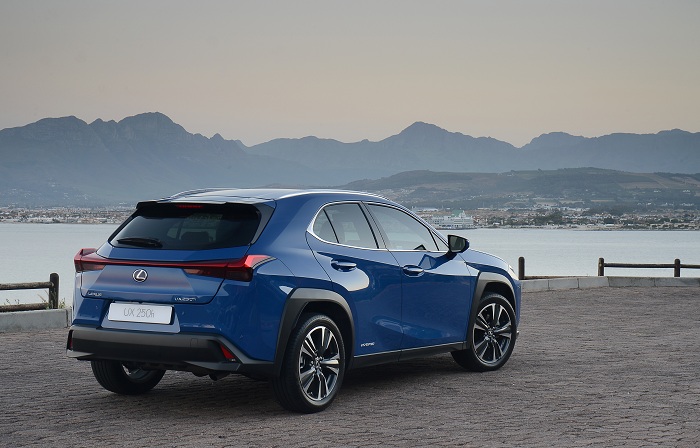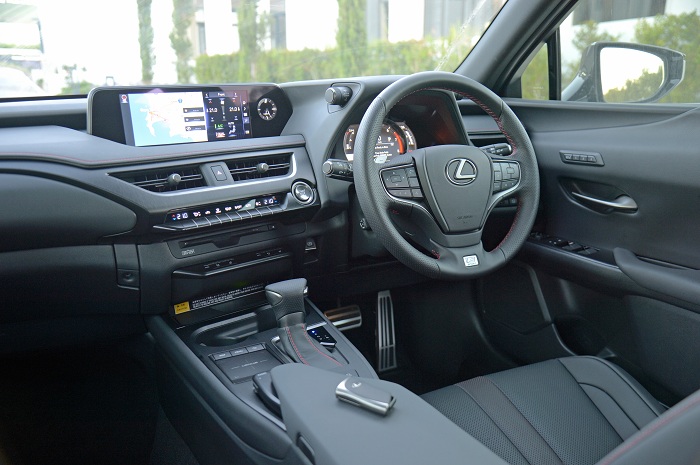Aim is clear
Unveiled at the Geneva Motor Show last year with its name denoting “urban crossover”, the UX not only replaces the bigger NX as Lexus’ smallest SUV/ crossover offering but also looks to take the fight to the likes of the Audi Q3, Volvo XC40, BMW X1 and the Mercedes-Benz GLA.
Arguably the most striking model to wear the now familiar Spindle Grille, the recent local media launch in Cape Town of what Lexus views as its model cash-cow came as somewhat of a surprise as it, to an extent, goes against the marque’s often staid image, notwithstanding its halo offerings such as the LC and LFA.
Funky and bold written all-over

Based on Toyota’s TNGA platform, but which Lexus refers to as Global Architecture-Compact (GA-C), the UX ups the daring factor considerably when viewed next to its contemporaries, with the aforementioned grille, aggressive LED headlights, outstretching bonnet, curved shoulder line, rear taillights that run the length of the rear facia and low-slung appearance providing for a sporty yet masculine looking entrant into a segment.
Premium interior hides a few quirks
It is a similar story inside where the UX’s interior feels typically premium with soft-touch materials on nearly surface, but with a modern, minimalist design thanks to the sweeping dashboard, the new 10.25-inch touchscreen infotainment system, the seven-inch TFT LFA derived instrument cluster and the centre facia that portrays a cocoon effect by being angled towards the driver.
The launch route leading out of the Mother City and into the Winelands before taking on coastal towns such as Muizenberg, Kalk Bay and False Bay did however show the UX’s ergonomic foibles in that the electrically adjustable telescopic steering column simply does not provide enough rake support no matter how low you drop the electric driver’s chair, while the touchpad-like controller with haptic feedback for the infotainment system still rates as irksome and somewhat of a pain to use.

Offsetting the system to a degree though are the thumb sensitive toggle switches for the radio and navigation neatly integrated into the armrest, which also doubles up as a centre storage area whose lid can be opened from either side.
While the cosseting nature of the UX will likely please those seated in the front, the rear bench is best described as snug with taller passengers likely to find headroom on the sparse side though a tad more spacious than the boot, which comes across as small in spite of there being a hidden compartment underneath the floor.
The drive
At launch, we were privy to drive the mid-range 250h SE and the flagship 200 F Sport with the line-up being completed by the entry-level 200 EX. In this guise, as well as the F Sport, power comes from an all-new normally aspirated 2.0-litre petrol engine that develops 126kW/206Nm, while in the SE, the engine is mated to an electric motor that delivers a total output of 135kW/188Nm. Drive is routed to the front wheels via a new CVT gearbox dubbed Direct Shift, which features a fixed first gear aimed at improving take-off.
In combined form, the UX made an immediate impression with the hybrid, unsurprisingly, feeling quick out of the blocks and the power delivery instant. In spite of lacking paddle shifters but coming with three driving modes; Eco, Normal and Sport, the CVT rates as one of the best currently on sale with the usual smooth, unnoticeable shifts in everyday situations, but then comes alive when you select the latter mode with faster changes and less of the irritating whine normally found with this type of ‘box.
Left without electrical assistance, the engine did, however, labour a bit and only really came to the boil with the F Sport exclusive Sport+ mode selected. The sole model to also get Lexus’ Adaptive Variable Suspension and the bigger eight-inch TFT setup, the F Sport felt sharper around the tight bends above Muizenberg and with little in the way of body roll, while the ride was firm but compliant even when the terrain became somewhat pockmarked.
At cruising speed, there is little to fault the UX with excellent levels of refinement and a myriad of standard comfort and safety equipment that is too extensive to mention in this article.
Conclusion
A great amount of pressure comes heaped upon the rounded shoulders of the UX to succeed in an area where Lexus often plays a left-field role, though it manages to largely pull this off.
Reservations, however, remain about the fussy infotainment system and its interface, the perceived buyer notion of a Lexus for a younger audience and the rather high price tag relative to its rivals. That said, it lacks little in the spec department and as a way of standing out, it makes a bold statement that will get noticed.
Pricing and Warranty
Standard on all models is a seven year/105 000km warranty and maintenance plan
UX200 EX - R599 000
UX250h SE - R699 000
UX200 F Sport - R726 200
















